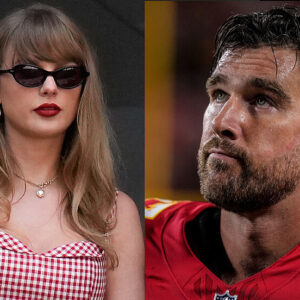
But it was also a narrative of perpetual cringe that masked something altogether more troubling, and concealed some of our own complicity in it. And by the time Bieber was cancelling gigs and appearing listless and unhappy on stage in 2017, there were signs that all was not right. Suddenly Bieber was an obnoxious child star gone off the rails in a sea of money and attention, but also a deeply troubled tragedy waiting to happen.
Last night, Bieber took to Instagram to confirm a hiatus from music, acknowledging that he is now “focused on repairing some of the deep rooted issues that I have… so that I don’t fall apart.” Now married, open about the scars left behind from years of outsized fame and embedded in a celebrity-friendly mega-church, Bieber is a new and incredibly God-fearing man, and one still working through the after-effects of an adolescence no teenager is ever psychologically prepared for. And it might just prove to be his salvation.
There was a point in time where no one outside of his frothing-at-the-mouth fanbase legitimately liked Justin Bieber. A walking embodiment of cheesy jokes about Canada’s inherent lack of cool, the young Bieber was pouty and over-styled, a 12-year-old plucked from YouTube obscurity and turned into a star, his output full of trite R&B numbers about puppy love and PG-rated canoodling.
He was also a budding tyrant privately embarking on a reign of terror behind the scenes. Just last week, US talk show host Wendy Williams recalled an incident 10 years ago in which to get the then 15-year-old Bieber on her show, her producers were asked to procure dozens of pre-teen girls to scream hysterically over his arrival. She also revealed his early brattish ways, claiming that even Bieber’s beleaguered mother Patty wasn’t “able to contain him.”

Justin Bieber and Hailey Baldwin
She added, “Everything that he did, she would come behind and say, ‘Sorry, I’m sorry for him,’ and he just wasn’t having it. He wasn’t mean to her, but he wasn’t having it from her, us, you, none of ‘em. And then he sang and he became big.”
Others working behind the scenes have been similarly vocal. Former Saturday Night Live comedian Bill Hader claimed in 2013 that Bieber was the show’s worst-behaved celebrity guest, as well as being impossible to work with. He reportedly arrived on the set of the sketch show with an elaborate entourage, including two individuals whose sole job was to hold onto Bieber’s food. In 2018, Hader went further.
“He just was in a bad place,” he told US talk show host Andy Cohen. “Maybe he’s in a better place. But then, it was rough… Everyone’s usually on great behaviour. Everyone’s very excited, and great behaviour. Most times, it’s 100 per cent. And Bieber’s the only one in my experience. I think he just seemed exhausted, or he was at the end of a rope. He was just so huge.”

Justin Bieber leaving a Miami Correctional Center after being arrested for drunk driving, in January 2014 CREDIT: getty
Bieber was at the centre of two extremes: a rabid fanbase of teenage girls, known as Beliebers, who were all deliriously infatuated with him, and everyone else who couldn’t stand him. A 2010 clip of Bieber being shot to death in an episode of CSI was inescapable during Twitter’s early days, while his infamous appearance in 2013 at Amsterdam’s Anne Frank Museum, in which he wrote in the museum’s guestbook that he had hoped the Holocaust victim “would have been a Belieber”, only furthered the idea of the pop star being hopelessly ignorant.
That same year, he was caught on camera urinating into a janitor’s mop bucket at a New York restaurant, an incident that gave way to a run of stories about his behaviour. By the end of 2014, he had been charged twice with vandalism, including an incident in which he had pelted a neighbour’s house with eggs, arrested for driving under the influence and had regularly engaged in physical fights with paparazzi photographers. An old video from his teenage years, in which he was shown making racist jokes, had been leaked online, and a petition to have him deported back to Canada had been signed by nearly 3000 people.
Bieber’s behaviour made it easy for many of us to justifiably despise him. Amid an odd feud with the star in 2014, Seth Rogen joked during a daytime talk show appearance that his dislike of Bieber wasn’t unusual. Turning to the show’s off-camera crew, he added: “None of these people in this room like Justin Bieber. I can guarantee you that.”

Justin Bieber at the MTV Video Music Awards in 2011 CREDIT: MARIO ANZUONI/ Reuters
But there was always an ugliness to that dislike, of which many of us gleefully took part in. Whether he was obnoxious or not, Bieber was experiencing a surreal level of fame and adulation that few young people could handle well, surrounded by hangers-on eager for their own moment in the spotlight, and propped up by a management team determined to make as much money from their star as possible.
Like Britney Spears before him, it was a level of expectation, attention and public mockery that understandably took a toll. But because Spears’s trauma only ever manifested as a kind of self-destruction that exclusively harmed herself, in comparison to Bieber’s self-aggrandising disregard for his neighbours, janitorial staff, primates and murdered children, it was harder for us to care. That still wasn’t particularly good of us, though.
In 2016, Bieber took to Instagram to declare that he was no longer taking part in meet-and-greets with fans at his concerts, claiming that they were leaving him “drained and unhappy.” “I want to make people smile and happy but not at my expense and I always leave feeling mentally and emotionally exhausted to the point of depression,” he added.
The tour in question would collapse as it went on, with Bieber walking off stage in Manchester and repeatedly begging his audiences to stop screaming. “Can you guys just relax for about two seconds?” he said in Birmingham. “I get it, but I’m like two feet away from you. And I can hear you. I appreciate all the love, it’s amazing. But can you show it in a different way? Screaming is just so obnoxious.” He would pull the tour entirely shortly after.
Behind the scenes, Bieber’s life was reportedly imploding. Along with a destructive on-again/off-again relationship with Selena Gomez, who herself has struggled with depression and health issues, Bieber was reportedly self-medicating, leaving many of his allies concerned about his well-being.
“There was a time when I would go to sleep almost every night – when he had the money to fly away from me – and I was worried every night that I was gonna lose him,” Bieber’s long-time manager Scooter Braun revealed last year. “I thought he was going to die. I thought he was going to sleep one night and that he would have so much crap in his system that he would not wake up the next morning. I was trying to monitor him from a distance, I would fly after him at times, all kinds of different stuff.”
As Braun told it, only one man could get through to Bieber, and that man was Jesus. A lapsed Evangelical prior to becoming a star, Bieber has gradually returned to the church over the past five years, befriending a pair of “celebrity pastors” known as Judah Smith and Carl Lentz, who helped Bieber turn his life around following years in the metaphorical desert of late-night parties and paternity tests.
According to an extensive 2015 story in GQ by journalist Taffy Brodesser-Akner, Bieber had undergone “an emergency baptism” in a bathtub belonging to a New York Knicks player, and would gradually become the Tom Cruise figure of Hillsong, a hipster megachurch with pastors dressed in skinny jeans and the likes of Chris Pratt and Kendall Jenner prosthelytizing from the pews.
In 2017, Australian tabloids reported that Bieber had turned his back on music to devote all of his time to his spiritual re-awakening, assisted by Hillsong, which had been founded in the country in 1983. And while the story was ripe for further jokes, particularly the claim that Bieber was considering launching his own religion entirely, it is today worth wondering if it has indeed rescued the star from oblivion.
Bieber’s transformation hasn’t been achieved overnight, and he has admitted to being a work in progress. Now married to fellow Hillsonger Hailey Baldwin, a model and the daughter of third-tier Baldwin brother Stephen, Bieber has recently been open about his depression and his past reliance on prescription drugs. Speaking to Vogue in February, he claimed that being famous for much of his adolescence had left him uncertain about his own identity.
“I’m still processing so much stuff that I haven’t talked about. I was lonely. I needed some time,” he said, in reference to his cancelled 2017 tour. “I’ve been successful since I was 13, so I didn’t really have a chance to find who I was apart from what I did.”
He also admitted to having lost himself in fame, adding: “I started really feeling myself too much. ‘People love me, I’m the s–-.’ That’s honestly what I thought. I got very arrogant and cocky. I was wearing sunglasses inside.”
As followers of celebrity culture, we gain unusual pleasure from watching a public downfall, but not quite as much as we love a celebrity comeback – the moment a star returns from the grim abyss with a new designer haircut and fresh outlook on life, aware of their past mistakes and eager to make amends. But it’s often a longer journey than we like to imagine, one that doesn’t always suit our own personal timelines.

Justin Bieber with his sister Jazmyn in 2011 CREDIT: getty
When Amanda Bynes made her first significant public appearance in years with a glamorous photoshoot and interview for Paper Magazine last November, it was widely celebrated as a return to form. An entire generation of her fans remembered with fond nostalgia the years before she had become a walking punchline and damaged soul wandering the streets of New York in a bad wig. But what has attracted less press is her recent return to a mental health facility following an alleged relapse, with TMZ reporting that her PR comeback and her return to the Hollywood audition circuit was too much, too soon.
So Bieber’s continued hiatus is worth celebrating, with a star (and his minders) finally acknowledging that mental health and continued sobriety is more important to maintain than the size of their bank balance. The Vogue piece saw Bieber declare that he isn’t quite as Evangelical as the tabloids have painted him to be, but he appears to have taken to heart many of the more philosophical teachings Hillsong has sent his way, vaguely referencing his recent decision to improve “character stuff” within himself.
Dislike of Bieber is so ingrained in the fabric of modern celebrity snark that it still feels slightly disquieting to express empathy for him, but it’s something we ought to strive for. Few would be able to survive his level of teenage fame, and our own awareness of the many fallen teen idols that came before him should be enough to make us collectively recognise its toxicity and how destructive it can be. That he was such a monster during most of it, the very pinnacle of pint-sized, douche-bro horror, should no longer be the entire conversation.
Relative Articles
None found





